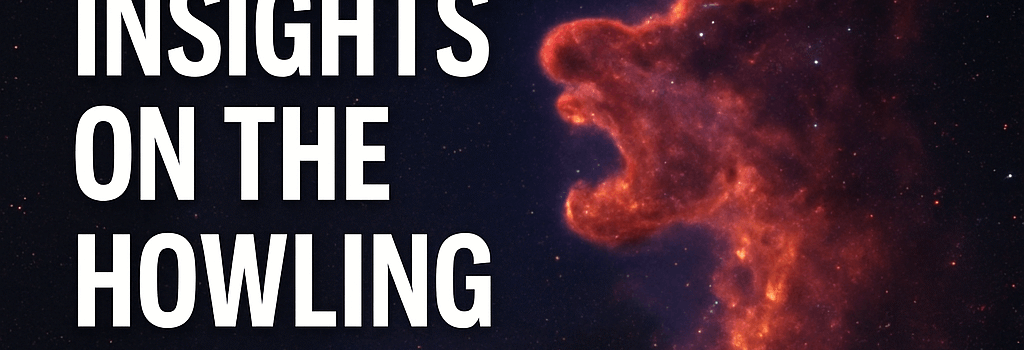Tuesday Telescope: Insights on the Howling Wolf of Cygnus

Introduction
Welcome back to the Tuesday Telescope, where we cut through the darkness (and the pseudoscience) to bring you the brightest phenomena our universe has to offer. Today we revisit one of the sky’s most enigmatic objects: WR 134, a Wolf-Rayet star in the constellation Cygnus. With fresh data from Gaia and the James Webb Space Telescope (JWST), we can deepen our understanding of these massive stellar powerhouses.
Historical Discovery and Early Mysteries
In the mid-19th century, astronomers began to notice stars with strange, broad emission lines. The 1868 discovery of helium in the solar spectrum by Jules Janssen and Norman Lockyer provided the key to decoding these anomalies. In 1867, French astronomers Charles Wolf and Georges Rayet cataloged three such stars—hence the name Wolf-Rayet (WR).
Spectral Signature of Wolf-Rayet Stars
- Strong Helium and Nitrogen Lines: Wolf-Rayet spectra are dominated by He II and N III–V transitions at wavelengths around 4686 Å and 4600–4750 Å.
- Broad Emission Profiles: Resulting from stellar winds with terminal velocities of 1,500–5,000 km/s.
- High Mass-Loss Rates: On the order of 10⁻⁵ to 10⁻⁴ M☉/yr, driving powerful circumstellar nebulae.
WR 134: Observational Highlights
Located approximately 6,000 light-years away, WR 134 is a WN6 subtype star. Amateur astrophotographer Chris McGrew captured a deep exposure from southwestern New Mexico, revealing:
- The glowing blue shell of ionized oxygen (O III) at 5007 Å.
- A faint halo of nitrogen and helium emission tracing the wind-blown bubble.
- Variability in brightness (ΔV≈0.03 mag) linked to clumps in the stellar wind.
“Ever since I saw it for the first time, it’s been high on my list,” McGrew says. “The combination of complexity and contrast makes WR 134 a compelling target for any deep-sky enthusiast.”
Recent Advances: JWST, Gaia & Ground-Based Campaigns
In 2024, JWST’s NIRSpec obtained high-resolution spectra of several Wolf-Rayet stars including WR 134, identifying fine-structure lines of [Ne II] at 12.8 μm and [S IV] at 10.5 μm for the first time. Meanwhile, Gaia DR3 refined WR 134’s parallax to 0.55 ± 0.03 mas, tightening its distance measurement to 5.8 ± 0.3 kly.
Role in Stellar Evolution and Supernova Progenitors
Wolf-Rayet stars represent a late evolutionary phase of massive O-type stars. Stripped of their hydrogen envelopes by intense winds, they are prime candidates for Type Ib/c supernovae and long-duration gamma-ray bursts. Current stellar evolution models (e.g., MESA, Geneva) predict a core mass of ~12 M☉ for WR 134, suggesting an imminent collapse within the next 100,000 years.
Technical Specifications and Observational Techniques
Equipment and Imaging Setup
- Telescope: 12″ Ritchey–Chrétien
- Camera: sCMOS cooled to –20 °C
- Filters: O III narrowband (6 nm FWHM), Hα (5 nm FWHM)
- Total Exposure: 6 hours (12 × 30 min)
Spectroscopy Parameters
- Spectrograph: R~10,000 echelle
- Wavelength Range: 380–700 nm
- Resolution: Δλ ~0.05 Å
Expert Opinions and Future Prospects
Dr. Selena Villanueva (University of Texas at Austin) notes, “The combination of JWST mid-IR data and ground-based optical spectroscopy allows us to map the wind structure and chemical stratification in unprecedented detail.” Looking ahead, the Vera Rubin Observatory’s time-domain surveys will track variability in hundreds of Wolf-Rayet stars, potentially catching pre-supernova outbursts.
Submit Your Telescope Images
Have a stunning deep-sky capture? Reach out to join the Tuesday Telescope gallery.
About the Author
Eric Berger is Ars Technica’s senior space editor, meteorologist, and author of Liftoff and Reentry. Based in Houston, he chronicles everything from NASA policy to private space ventures.